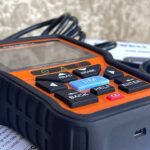Navigating the world of car diagnostics can be tricky, especially when dealing with vehicles from before 1996. If you’re trying to troubleshoot issues with an older car, particularly a Volvo, using a modern OBD scanner might not give you the full picture. Let’s delve into why this is the case and explore the best approaches to diagnose your pre-1996 vehicle.
For owners of older Volvos, a quick peek under the hood can reveal a valuable diagnostic resource often overlooked in favor of OBD scanners. Have you checked for the Volvo diagnostic boxes typically located near the windshield wiper fluid reservoir? These boxes are often more effective for these older models than relying solely on first-generation OBD ports.
Understanding Early OBD Systems for Pre-1996 Cars
The early days of On-Board Diagnostics (OBD) were not as standardized as they are today. For cars manufactured before 1996, the systems were quite different and less comprehensive than the OBD-II standard we’re now familiar with. It’s important to understand that the OBD system in older cars, including some early Volvos, may not fully align with modern OBD-II scanners.
It’s been noted that even within the early OBD era, variations existed. For instance, there’s information suggesting that Canadian-market cars might have had a slightly different early OBD implementation compared to those in the U.S. Although this is still debated, it highlights the complexity of early diagnostic systems.
Alt text: Location of Volvo diagnostic boxes under the hood of a pre-1996 car, near the windshield wiper reservoir, used for vehicle diagnostics instead of standard OBD scanner ports.
ISO Standards and OBD Compatibility
The first versions of OBD in vehicles like older Volvos often utilized the ISO-9141-2 standard. This is different from the later OBD-II standard, ISO 14230-4, which became more prevalent in ’98 and ’99 and newer models. Sometimes, these are referred to as OBD-I and OBD-II, although the terminology isn’t strictly accurate.
The crucial point here is compatibility. If your OBD scanner is designed primarily for the later ISO 14230-4 OBDII standard, it might struggle to properly communicate with a pre-1996 car using the ISO-9141-2 protocol. This mismatch could be the reason why you might be encountering difficulties retrieving diagnostic trouble codes.
Volvo Diagnostic Boxes: A Specific Advantage
Volvo, in particular, equipped some of their older models with proprietary diagnostic boxes. These Volvo-specific systems can often provide more detailed and accurate information about your car’s health compared to a generic OBD reading on a first-generation port. They are tailored to the specific systems within your Volvo.
While Volvo also uses some specific pins in their diagnostic systems, primarily for their Volvo Scan Tool (VST), these are generally not essential for basic diagnostics by non-professional Volvo owners. The key advantage for owners is often found within the Volvo diagnostic boxes themselves, providing deeper insights into potential issues.
Choosing the Right Approach for Diagnostics on Cars Under 1996
When diagnosing a car manufactured before 1996, especially a Volvo, consider these steps:
- Check for Volvo Diagnostic Boxes: First and foremost, locate and investigate the Volvo diagnostic boxes under the hood. These might offer more specific and helpful codes than a generic OBD port.
- Verify OBD Scanner Compatibility: If you intend to use an OBD scanner, ensure it is compatible with the ISO-9141-2 standard, which is common in older vehicles. Many modern scanners are designed for OBD-II and might not fully support these older protocols.
- Consider Specialized Tools: For in-depth diagnostics on older Volvos, exploring Volvo-specific scan tools or consulting resources related to Volvo’s diagnostic box systems can be beneficial.
In Conclusion
For cars under 1996, particularly Volvos of that era, diagnosing issues requires a slightly different approach. While OBD scanners can be useful, understanding the early OBD standards and the potential advantages of Volvo’s own diagnostic boxes is crucial. By considering these factors, you’ll be better equipped to accurately diagnose and maintain your classic vehicle.

